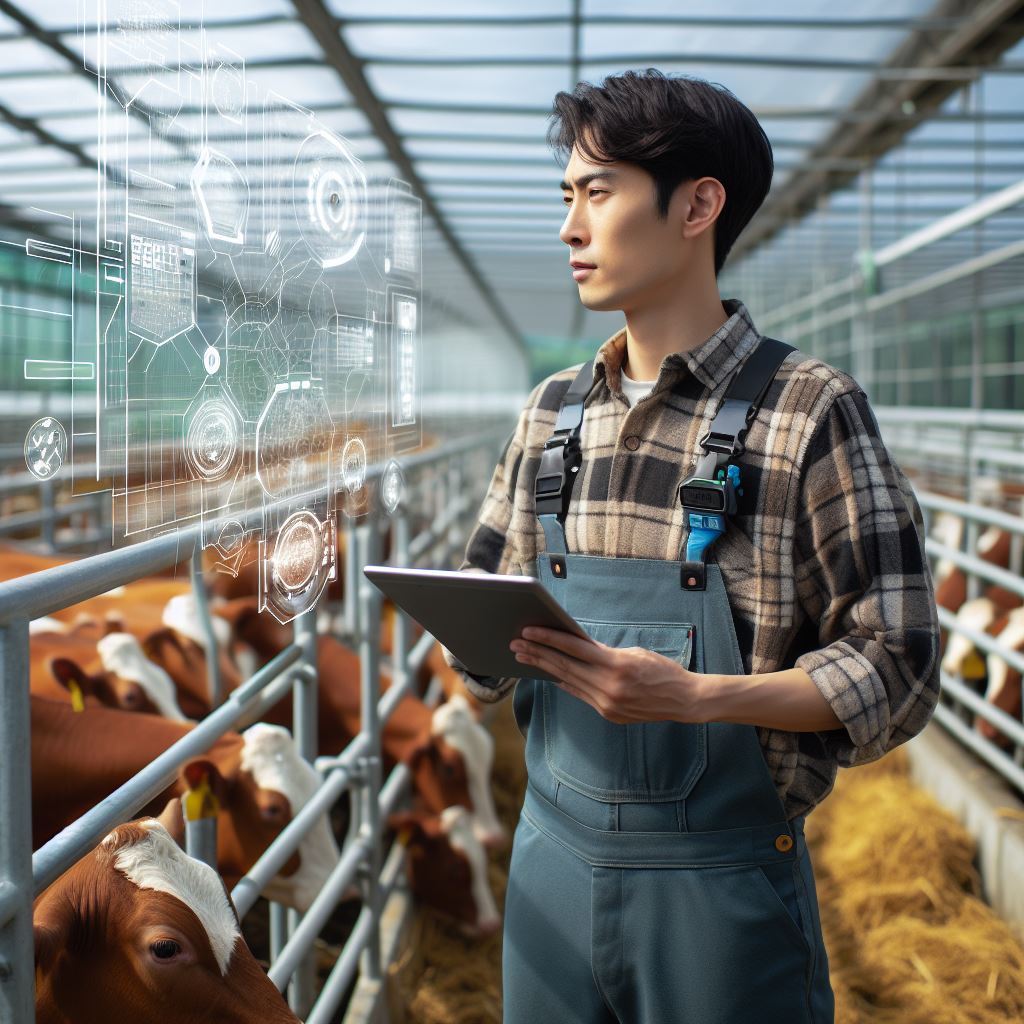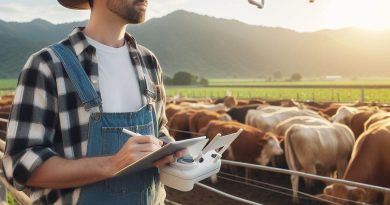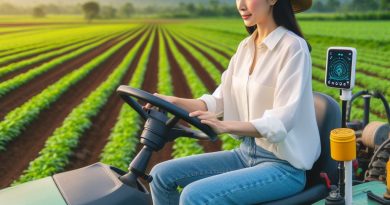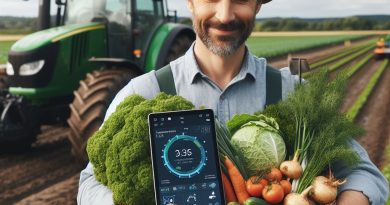Virtual Fencing: The Future of Herding
Last Updated on January 24, 2024
Introduction
Definition of virtual fencing
Virtual fencing is a groundbreaking technology that is revolutionizing the way livestock is herded.
Unlike traditional herding methods, virtual fencing utilizes electronic devices to control the movement of livestock without the need for physical barriers.
Traditional herding methods typically involve the presence of herders or sheepdogs, who use their presence and guiding commands to direct the livestock.
This requires physical effort and continuous monitoring by the herders, which can be time-consuming and labor-intensive.
Importance of herding in agriculture
The importance of herding in agriculture cannot be overstated.
Livestock management is a fundamental aspect of agricultural practices, ensuring the health, safety, and optimal utilization of resources.
Herding helps in maintaining the desired grazing patterns, preventing overgrazing in specific areas.
It also aids in protecting livestock from predators and potential hazards in the environment.
Virtual fencing offers several advantages over traditional herding methods.
It provides a more efficient and cost-effective solution by reducing labor and infrastructure requirements.
It allows livestock to roam freely within predetermined boundaries, eliminating the need for physical barriers while maintaining control over their movement.
Moreover, virtual fencing allows for better management and monitoring of livestock.
Real-time data collection and analysis enable farmers to make informed decisions regarding their animals’ health, nutrition, and well-being.
This technology also facilitates the integration of precision agriculture approaches by enabling farmers to remotely monitor and manage their livestock, improving overall agricultural productivity.
Basically, virtual fencing has the potential to transform the future of herding by providing a more efficient, economical, and precise solution.
It offers numerous benefits over traditional herding methods, making it an invaluable tool for livestock management in modern agriculture.
The concept of virtual fencing
Explanation of how it works
Virtual fencing is a modern approach to herding that utilizes innovative technology to replace traditional physical fences.
Instead of using physical barriers, virtual fencing relies on electronic systems to contain and guide animals.
The system consists of a central control unit connected to various sensors strategically placed around the designated area.
These sensors detect the animal’s position and movements, ensuring they stay within the desired boundaries.
Using an active voice, virtual fencing constantly monitors the animal’s location and sends signals when they approach the virtual boundaries.
The control unit then triggers cues that the animals have been trained to respond to, guiding them away from restricted areas and keeping them within the defined limits.
Use of technology
Virtual fencing employs an array of advanced technologies to create effective and reliable boundaries for herding livestock.
Sensors, such as GPS and accelerometers, play a crucial role in accurately tracking the animals’ location and movements.
GPS technology enables precise positioning, which ensures that the virtual boundaries are accurately established and maintained.
Accelerometers help measure the animal’s activity, allowing the system to adapt to their behavior and ensure effective containment.
Furthermore, the control unit communicates with wearable devices attached to the animals, such as collars or ear tags.
These devices receive signals from the central unit and relay them to the animals through vibrations or sounds, guiding them away from restricted areas or towards desired locations.
Advantages over traditional fencing
Virtual fencing offers numerous advantages over traditional physical fencing methods, revolutionizing the way animals are herded.
- Cost-effective: Traditional fencing requires continuous maintenance, repairs, and replacement, which can be time-consuming and costly. In contrast, virtual fencing reduces these expenses as it relies on technology rather than physical barriers.
- Flexibility and adaptability: Virtual fencing allows for easy reconfiguration of boundaries and movement of herds. Unlike physical fences, which are fixed in place, virtual fences can be adjusted to accommodate changes in grazing areas or rotational grazing patterns.
- Improved animal welfare: Physical fences can sometimes pose safety risks to animals, leading to injuries or entanglement. Virtual fencing eliminates these risks, providing a safer environment for animals to graze and roam freely.
- Environmental preservation: Traditional fencing can disrupt natural ecosystems and restrict wildlife movements. Virtual fencing minimizes environmental impact by eliminating the need for physical barriers, allowing wildlife to move freely while still maintaining a clear boundary for livestock.
- Enhanced herd management: With virtual fencing, herders can closely monitor their animals’ behavior and movement patterns. This data can be analyzed to optimize grazing strategies and improve overall herd health and productivity.
Essentially, virtual fencing is a game-changer for herding practices, offering a technologically advanced and cost-effective alternative to traditional physical barriers.
By harnessing the power of sensors, GPS, and wearable devices, virtual fencing provides flexibility, safety, and improved animal welfare while minimizing environmental impact.
This innovative approach is set to shape the future of herding, ensuring efficient management and harmonious coexistence between livestock and the environment.
Read: GPS Tracking: Transforming Herd Management
Benefits of virtual fencing in herding
Flexibility in creating boundaries
Virtual fencing allows herders to easily create and adjust boundaries based on their specific needs.
They can use GPS technology to draw virtual boundaries on a map, saving time and effort.
This flexibility enables herders to effectively manage their livestock without the need for physical fences.
Improved animal welfare
Virtual fencing eliminates the use of physical barriers, reducing the risk of injuries and stress for animals.
Without the limitations of traditional fences, animals have more freedom to roam and engage in natural behaviors.
This results in improved well-being and overall animal welfare, leading to healthier and more productive livestock.
Cost savings for farmers
The installation and maintenance of traditional fences can be costly for farmers.
Virtual fencing offers a more cost-effective alternative, as the need for physical materials is eliminated.
It also eliminates the need for frequent repairs and replacements, further reducing expenses in the long run.
Virtual fencing systems can be easily moved and reused, providing additional cost savings for farmers.
Reduced environmental impact
Physical fences can have a negative impact on the environment.
They require the use of materials such as wood or wire, contributing to deforestation and resource depletion.
Virtual fencing, on the other hand, is environmentally friendly as it does not require these materials.
By opting for virtual fencing, farmers can contribute to the conservation and sustainability of natural resources.
- Virtual fencing offers various benefits in herding, including flexibility in creating boundaries.
- It allows herders to easily adjust boundaries based on their needs using GPS technology.
- Virtual fencing improves animal welfare by eliminating physical barriers and promoting natural behaviors.
- It also provides cost savings for farmers as it eliminates the need for expensive materials and frequent repairs.
- Virtual fencing reduces the environmental impact associated with traditional fences.
Overall, virtual fencing is a promising solution for herding that enhances productivity, animal welfare, and environmental sustainability.
Read: IoT in Agriculture: Livestock Applications
Case studies of successful virtual fencing implementation
Example 1: Cattle herding on large ranches
- Virtual fencing has been successfully implemented in cattle herding on large ranches.
- Sensors and GPS technology are used to create virtual boundaries for the cattle.
- This allows ranchers to easily herd and manage their cattle without physical fences.
- Virtual fencing has proven to be highly effective in preventing cattle from wandering off.
- It also reduces the need for manual labor and maintenance of physical fences.
Example 2: Sheep herding in hilly terrain
- Virtual fencing has also been successfully implemented in sheep herding in hilly terrain.
- The use of GPS technology allows shepherds to easily set virtual boundaries for the sheep.
- This allows the sheep to graze freely without the need for physical fences.
- Virtual fencing has been effective in preventing sheep from straying into dangerous areas.
- It also allows shepherds to focus on other tasks rather than constantly monitoring the sheep.
Positive outcomes and feedback from farmers
- Farmers who have implemented virtual fencing have reported numerous positive outcomes.
- It has significantly reduced the costs associated with traditional physical fences.
- Virtual fencing has improved the overall efficiency and productivity of herding operations.
- It has also provided farmers with better control and management of their livestock.
- Farmers appreciate the flexibility and ease of use that virtual fencing provides.
- The ability to easily adjust boundaries and herd livestock with minimal effort is highly valued.
- Virtual fencing has gained widespread popularity among farmers and is seen as the future of herding.
In general, case studies of successful virtual fencing implementation in cattle herding on large ranches and sheep herding in hilly terrain demonstrate the effectiveness of this technology.
Farmers have reported numerous positive outcomes, including cost reduction and improved efficiency.
Read: Livestock Genetics: Tech-Driven Breeding

Potential challenges and limitations
Accuracy and reliability of technology
- The success of virtual fencing relies heavily on the accuracy and reliability of the technology used.
- Inaccurate detection or delayed response by the virtual fences can lead to ineffective herding.
- Technical malfunctions, such as system failures or false alarms, can disrupt the entire herding process.
- Ongoing advancements and rigorous testing are necessary to ensure the technology’s accuracy and reliability.
Impact on herding dogs and their training
- Virtual fencing may require a significant adjustment for herding dogs who are accustomed to traditional physical fences.
- Dogs need to be trained to respond to virtual boundaries, which may take time and effort.
- There could be potential behavioral changes in dogs due to the transition from physical to virtual barriers.
- Some herding dogs may struggle with understanding and adapting to virtual boundaries, affecting their effectiveness.
Initial investment and ongoing maintenance costs
- Implementing virtual fencing systems can involve substantial initial investment costs.
- High-quality technology, software, and infrastructure must be acquired to ensure efficiency.
- Training personnel to install and maintain virtual fences requires additional expenses.
- Ongoing maintenance costs, including upgrades and repairs, should be considered in the budget.
- The overall cost-effectiveness and return on investment of virtual fencing need to be carefully evaluated.
Accuracy and reliability of technology
The accuracy and reliability of the technology used is crucial for the success of virtual fencing.
Any inaccuracies or delays in response can hinder effective herding.
Ongoing advancements and robust testing protocols are necessary to ensure the technology’s effectiveness.
Initial investment and ongoing maintenance costs
The impact on herding dogs and their training should be considered.
Virtual fencing may require dogs to adapt to a new method of boundary containment, which may take time and effort.
There could also be potential behavioral changes in dogs due to the transition from physical to virtual barriers.
Some herding dogs may struggle with understanding and adapting to virtual boundaries, affecting their effectiveness in herding tasks.
Initial investment and ongoing maintenance costs
The implementation of virtual fencing systems involves significant initial investment costs.
Acquiring high-quality technology, software, and infrastructure is vital for efficient functioning.
Training personnel to install and maintain virtual fences also adds to the expenses.
Ongoing maintenance costs, including upgrades and repairs, should be factored into the budget.
Careful evaluation of the overall cost-effectiveness and return on investment is essential for decision-making.
Potential of virtual fencing
Despite these potential challenges, virtual fencing holds immense potential for revolutionizing the herding industry.
Continuous research, development, and improvement of the technology can address these limitations and enhance the effectiveness and reliability of virtual fences.
Additionally, with time and appropriate training methods, herding dogs can learn to adapt to virtual boundaries and perform their tasks efficiently.
Taking into account the initial investment and ongoing maintenance costs, it is crucial to weigh the potential benefits and advantages that virtual fencing can offer, such as increased flexibility in land usage, reduced physical barriers, and improved animal welfare.
By carefully addressing these challenges and limitations, virtual fencing can indeed become the future of herding.
Read: Sensor Tech in Livestock Care: An Insight
Future prospects of virtual fencing
Continuous improvements in technology
Virtual fencing is an ever-evolving technology that holds great promise for the future.
With advancements in technology, virtual fencing systems will become more efficient and reliable.
- Enhanced accuracy: Continuous improvement will lead to more precise and accurate virtual fencing systems.
- Better communication: Advancements in communication technology will enable seamless communication between the farmer and livestock.
- Integration of artificial intelligence: Incorporating AI into virtual fencing systems will improve decision-making and boundary enforcement.
Integration with other smart farming solutions
The future of virtual fencing lies in its integration with other smart farming solutions.
This integration will provide farmers with a comprehensive and streamlined approach to livestock management.
- Sensor integration: Integrating virtual fencing systems with sensors can provide additional data on livestock health and behavior.
- Automated data analysis: By combining virtual fencing data with other smart farming data, farmers can gain valuable insights into their livestock’s overall well-being.
- Increased automation: Virtual fencing can be integrated with robotic systems for tasks like feeding, health monitoring, and waste management.
Expansion of virtual fencing to other livestock
While virtual fencing has primarily been focused on cattle, the future holds potential for its expansion to other livestock.
- Sheep and goats: Virtual fencing can be adapted to suit the herding needs of sheep and goats, providing farmers with increased flexibility in their operations.
- Poultry: Innovations in virtual fencing technology may allow for the containment of free-range poultry, preventing them from straying into unwanted areas.
- Swine: Virtual fencing has the potential to revolutionize swine management by providing an alternative to physical barriers and allowing for more natural movement.
In a nutshell, virtual fencing has a bright future ahead with continuous improvements in technology, integration with other smart farming solutions, and expansion to other livestock.
Farmers can expect more efficient and accurate systems, a comprehensive approach to livestock management, and increased flexibility in livestock herding.
Conclusion
The technology allows for easier management of livestock, reducing labor and costs.
It also provides better control and flexibility in guiding animals without the need for physical barriers.
Farmers should seriously consider adopting this innovative approach in the future.
Virtual fencing not only improves efficiency and convenience but also proves to be more sustainable, promoting healthier pastures and reducing the negative impact on the environment.
With advancements in technology, we can expect further improvements and refinements in virtual fencing systems.
This will lead to better livestock management, increased productivity, and improved animal welfare.
As the agricultural industry evolves, it is crucial for farmers to stay open to new ideas and embrace innovative solutions like virtual fencing.
This technology has the potential to transform the way we approach herding, making it more efficient, sustainable, and adaptable to changing needs.
By investing in virtual fencing, farmers can achieve better outcomes for both their livestock and their own livelihoods.


